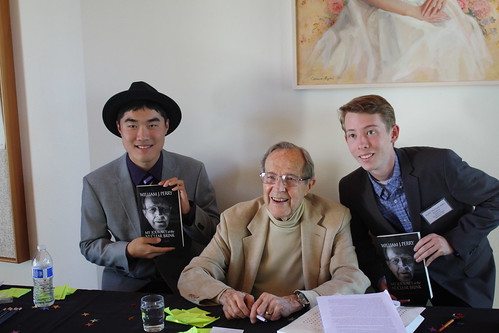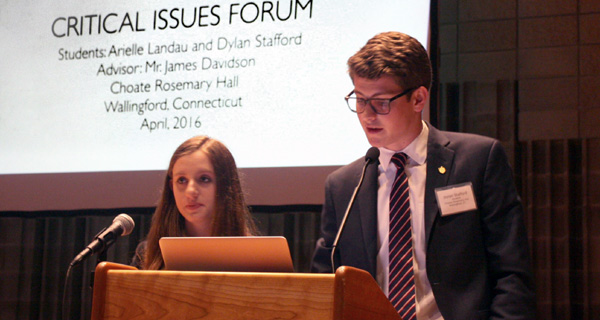Masako Toki
April 25, 2016
Students and teachers from Japan and Russia joined peers from the United States at a conference on nuclear nonproliferation and disarmament convened by the James Martin Center for Nonproliferation Studies (CNS) at the Middlebury Institute of International Studies at Monterey (MIIS). The conference featured former US Secretary of Defense William J. Perry. The Critical Issues Forum (CIF) annual conference took place on April 15-16 at Santa Catalina School in Monterey that co-hosted the conference.
Each year, the CIF conference takes place at a time when the world leaders are also tackling challenges posed by nuclear dangers. This year’s conference was no exception. This parallel timing underscores for the students that they are engaging with vital, real-world issues through the project. As dedicated students studying disarmament and nonproliferation, these young people will be essential to reducing nuclear risks and contributing to the goal of peace and security of a world free of nuclear weapons.
Just a few days before the CIF conference, the Group of Seven Foreign Ministers meeting was held in Hiroshima, and for the first time, the incumbent US secretary of state visited the Hiroshima Peace Memorial Museum. Also a few weeks prior to the CIF conference, President Barack Obama convened the final Nuclear Security Summit in Washington, DC, where over fifty world leaders gathered to take concrete measures to enhance nuclear security.
Former United States Secretary of Defense Dr. William Perry and his daughter, Ms. Robin Perry, joined the conference for the entire second day’s session, which featured a dialogue session between him and the students, moderated by Dr. William Potter, CNS founding director. This direct interaction with a former top-ranking US defense official who had been deeply involved in US nuclear weapons policy was an exciting and rare opportunity for participants.
As an additional enhancement to the prestige of the conference, Japanese Foreign Minister Fumio Kishida sent a congratulatory message to the CIF participants, delivered at the conference by Japanese Consul General in San Francisco Mr. Jun Yamada. Mr. Kishida himself participated last year’s CIF conference that was held in Hiroshima to greet participants. The CIF conference was also fortunate to have Professor Mitsuru Kurosawa from Osaka Jogakuin University and the founding president of the Japan Association of Disarmament Studies as a commentator.
Under this year’s theme, “Global Nuclear Vulnerability: Lessons for a More Secure and Peaceful World,” students held informed and dynamic discussions that built upon their semester-long preparation as part of the CIF project. Students and teachers effectively inspired each other and learned from other schools’ presentations. It is truly encouraging to see these young future leaders working together to find ways to reduce nuclear dangers.
Students’ Conference
The CIF conference on April 15 and 16 brought seven US high schools, six Japanese schools, and three Russian high schools to Santa Catalina to discuss global nuclear vulnerability, reducing nuclear dangers, and what each of these young leaders-in-training can do to make progress toward a goal of peace and security of a world free of nuclear weapons. Following an opening statement by Masako Toki, CIF project manager, Dr. William Potter warmly welcomed all the participants, congratulating their hard work to study this challenging but vital topic. He highlighted CNS’s mission to educate the next generation of nonproliferation specialists, and the importance of disarmament and nonproliferation education for high school students, which is very rare. As head of the hosting Upper School of Santa Catalina School, Dr. Kassandra Brenot cordially welcomed the participants from these three countries.
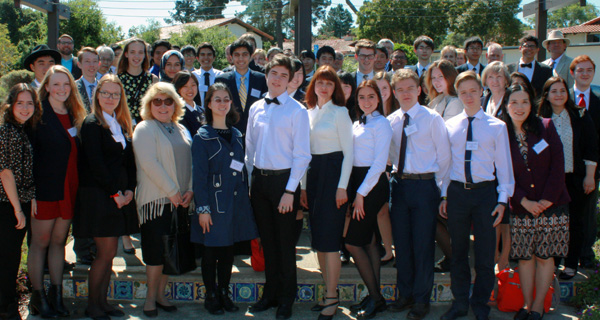
CIF participants from Japan, the United States and Russia at Santa Catalina School
Throughout the months of preparation for the conference, the students immersed themselves studying the topic, “Global Nuclear Vulnerability: Lessons for a More Secure and Peaceful World.” Students examined the dangers of the current nuclear weapons situation, and investigated how close the world has come to nuclear weapons use, and many concluded that, in some respects, the risk of nuclear weapons is greater today than it was during the Cold War. They also explored the ways in which international nonproliferation and disarmament regimes function to prevent nuclear weapons from being used. Students also explored ways to prevent any future use of nuclear weapons. Then, through meticulous, insightful, and creative research, students presented their own solutions to these problems, demonstrating a solid understanding of this sophisticated and complex challenge.
To supplement and expertly guide students’ own research, CIF teachers had participated in the previous December, in an online teachers’ workshop on the relevant subjects. Using lectures and educational materials prepared by CNS experts, each school worked hard toward the spring conference.
Student Presentation Highlights
In their presentation, students from the host school, Santa Catalina in Monterey, California, examined how to avoid nuclear weapons use both accidentally and intentionally. Students shared their idea to disarm the majority of the nuclear weapons in the world slowly and gradually while maintaining the world stability. Dr. Olga Mohan High School from Los Angeles focused on the North Korea’s nuclear threats and how to solve this dangerous situation. Their studies included the recent nuclear weapons tests and background information. The students also highlighted the likelihood of a North Korean nuclear accident. Before the conference, the students and teacher interviewed several nuclear experts, and concluded their presentation with the UN Secretary General Ban Ki- Moon’s principle: “there are no right hands for wrong weapons.”
As first time CIF participants, Punahou School from Hawaii students’ research included an interview with a survivor of the atomic bombing in Hiroshima. This research also explored past close calls, including the Cuban Missile Crisis and the 1983 Soviet Nuclear False Alarm incident. Students also delineated the current nuclear weapon status that continues to present threats to humanity. In order to reduce the nuclear dangers, the students argued that it is essential to raise awareness of such a danger among young people. Thus, they proposed that high schools should create an international issues club where students and teachers can actively discuss and find solutions to global challenges. They also proposed to collect petitions to take US nuclear weapons off hair-trigger alert. As an effort to promote nuclear disarmament education, the Punahou students also proposed to coordinate educational activities with Hiroshima peace scholars.
Students from one of CIF’s “veteran” high schools, Choate Rosemary Hall, explored several existing nuclear threats, such as the continued existence of thousands of nuclear warheads across the globe, their proliferation, their status, and modernization by some countries, as well as issues of nuclear terrorism. In their proposal, Choate students argued that any progress in nuclear nonproliferation and disarmament requires US leadership, and that US diplomatic leverage can encourage other nations to follow suit The decisive unilateral actions to reduce stockpiles and lower hair-trigger alert status are important steps. The students also examined other solutions including realignment of spending priorities to reduce nuclear weapons funding and changing public perceptions.
This year, six Japanese high schools participated, four of which were new to CIF—a warmly welcomed expansion of the project to other cities in Japan beyond Hiroshima and Nagasaki. One of the original schools, Hiroshima Jogakuin Senior High School, has been undertaking extensive nuclear disarmament and peace education activities, including meticulous scrutiny of excessive defense spending for nuclear weapons and the study of the risk of terrorist acquisition of nuclear materials or nuclear weapons. The students also highlighted lack of progress in nuclear disarmament. In order to achieve the goal of a world free of nuclear weapons, these students from the first city that was attacked by a nuclear weapon proposed to utilize education to promote nuclear disarmament. The students came up with an idea to create a special project entitled the Youth Education for a Nuclear Weapon Free World (YENFW) and create a universal textbook available online for free.
Another veteran school from Japan, Kwassui High School in Nagasaki, argued that nuclear weapons will never bring safety and security to the world, articulating three nuclear dangers: the use of nuclear weapons, nuclear weapons as deterrence, and nuclear weapons as a tool to gain interest. They investigated the reasons and causes behind these dangers, and how we can overcome them. The students argued that the current NPT regime is not sufficient to accomplish the goals of a world without nuclear weapons, highlighting the importance of creating a new treaty to ban nuclear weapons, as well as the need to raise awareness of the risk of nuclear weapons through educational activities among civil society, especially among young students.
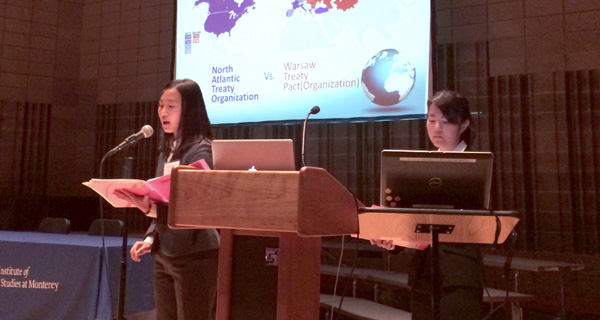
Nagasaki’s Kwassui High School students presentation, “IT’S NEVER SECURE - the myth of nuclear safety”
One of the first-time participants, Soka Senior High School in Tokyo, asserted the importance of a paradigm shift in nuclear weapons from the concept that nuclear weapons are a necessary evil to an absolute evil to humanity. In order to make this paradigm shift, students suggested that we should take a multi-track diplomacy approach. As part of the effort to promote the importance of achieving a world without nuclear weapons, students introduced their promotional and educational video project.
All student presentations will be posted on the CIF website.
Please see the CIF Conference Booklet for more information.
Keynote by and Conversation with Dr. William Perry
A highlight of this year’s CIF conference was the keynote speech by former Defense Secretary Dr. William Perry and the ensuing conversation with him and his daughter, Ms. Robin Perry.

Dr. William Perry, his daughter Robin Perry, and CNS Director Dr. William Potter in conversation with students
CNS Director Potter introduced Dr. Perry as a man whose name has become “synonymous with government service, integrity, and common sense.” Dr. Potter highlighted Dr. Perry’s tremendous work in galvanizing efforts to secure nuclear stockpiles inherited by former Soviet states and presiding over the dismantlement of more than 8,000 nuclear weapons.
Before he started his keynote address, Dr. Perry kindly applauded CNS for holding this “unique and insightful” educational conference, saluting Dr. Potter and CNS for “pioneering” nonproliferation and disarmament education, and tireless and creative efforts to promote such education. He emphasized the importance of education to reduce nuclear dangers, and highlighted that starting such education at the high school level is an effective way to spark a lifelong engagement with the issue.
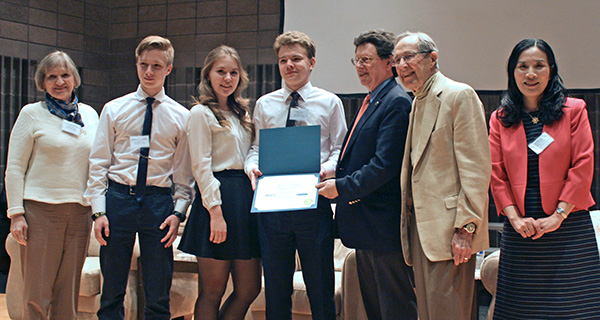
Russian students with William Potter, Dr. William Perry, and Masako Toki
In his keynote remarks, Dr. Perry shared his unique and insightful thoughts on nuclear dangers, culled from his own experience through his long-term government service, including as secretary of defense. After witnessing the nuclear devastation first-hand in Hiroshima only a few months after the bombing, his role as an analyst during the 1962 Cuban Missile Crisis, as well as subsequent further nuclear crises during his time in government, Dr. Perry’s appreciation of what nuclear weapons can do to human beings and environment is an important gift to have shared with all CIF participants.
Dr. Perry warned that we are now on the verge of a new nuclear arms race, and that we are drifting back to a Cold War mentality. The public, he said, is “blissfully unaware” of the new nuclear danger they face. He emphasized that the danger of nuclear catastrophe is greater today than it was during the Cold War. He is therefore is working tirelessly to reduce nuclear dangers through public education, especially youth: the best way, he said, “to deal with this nuclear problem is through education, and education has to start young, at high school.” This situation inspired him to write his new memoir, My Journey at the Nuclear Brink, which aims to educate the public about these dangers.
The conference also welcomed Ms. Robin Perry, Dr. Perry’s daughter and the executive director of the William J. Perry Project, which produced a grim animated short she shared with CIF participants.
While the scenario depicted in the film is fiction, it showcases the real plausibility of terrorists acquiring nuclear materials and developing an effective, improvised nuclear device. The project aims to educate and engage the public about the dangers of nuclear weapons in the twenty-first century.
After the video screening, Dr. Potter moderated the conversation between Dr. Perry and high school students. CIF students were not shy in asking questions to the former secretary of state. They lined up in front of microphones to ask Dr. Perry a variety of enthusiastic, interesting questions, including his views on how young students can fulfill the important role of reducing nuclear dangers, the dangers of North Korea’s nuclear threats, US-Russia relations, nuclear terrorism, and nuclear policies in the context of the US presidential election.
Message from Foreign Minister Fumio Kishida
Another treat for participants was the congratulatory message sent from Japanese Foreign Minister Mr. Fumio Kishida. Delivered by Mr. Jun Yamada, Japanese Consul General in San Francisco, Foreign Minister Kishida highlighted the historic G7 foreign ministers meeting in Hiroshima, which provided the ministers with a chance to visit the Hiroshima Peace Memorial Museum, lay wreaths at the Cenotaph for the atomic bomb victims, and visit the atomic bomb dome. Mr. Kishida, a Hiroshima native, is well known as a strong disarmament advocate and his efforts toward creating a world free of nuclear weapons through disarmament education for youth. As part of such effort, Mr. Kishida reiterated his announcement from the Hiroshima G7 meeting that Japan will expand the Youth Communicators for a World without Nuclear Weapons Program to other countries as well. Many CIF students were appointed official “Youth Communicators,” including some American and Russian students, the first non-Japanese students so appointed.
Consulate General of Japan in San Francisco Website: [Japanese], [English]
MIIS Gradate Students’ Panel Discussions
The CIF conference also engaged graduate students in nonproliferation and terrorism studies. These young scholars shared their experiences with how the MIIS nonproliferation studies impacted their career decisions. Hearing how MIIS students’ experience interning at the United Nations Office for Disarmament Affairs, working for various international disarmament and nonproliferation conferences—such as the Nuclear Nonproliferation Treaty Review Conference and the UN General Assembly meetings—encouraged and inspired these CIF high school students to continue their academic and professional endeavors in the field. During a question-and-answer session, the high school students asked the MIIS students for their advice in terms of educational and career opportunities in nonproliferation and disarmament.
Conclusion
This year’s CIF conference again proved the importance of disarmament and nonproliferation education for youth as a way toward achieving the peace and security of a world without nuclear weapons. As Dr. Perry stated in his speech, the first step we must take to reduce nuclear danger is education, and CNS efforts to engage high school students in such a dynamic and multifaceted manner is one important contribution.
These high school students worked tirelessly, thinking critically about this complicated nuclear issue in order to find their own, innovative solutions to reduce nuclear dangers and make progress in nuclear disarmament. Many of these students realized that they are the ones who are responsible to achieve that goal. CNS hopes that this type of educational project will give more opportunities to young students to further raise their awareness of these global challenges, strengthen their determination to work toward this goal, and start something they can do, no matter how small it may seem.
In his recent memoir, My Journey at the Nuclear Brink, Dr. Perry elucidated in its final chapter: “… Dealing with the problem of nuclear dangers will take decades, and will ultimately need to be solved by today’s youth, in America and around the globe. My generation dealt with the nuclear dangers of the Cold War; later generations must deal with the deadly nuclear legacy that we left behind.” For these youths to inherit this daunting task, education is essential.
This year’s CIF program is funded by the United States-Japan Foundation, a New York-based organization supporting activities to deepen friendship and understanding between American and Japanese citizens, and the Tokyo Club, Japan’s oldest and most prestigious private club. Learn more about the CIF program.
See Also
“Monterey plays host to disarmament conference for teens“, Monterey Herald, April 14, 2016.
Participating Schools
United States
Choate Rosemary Hall, Wallingford, CT
Harker School, San Jose, CA
Dr. Olga Mohan High School, Los Angeles, CA
Pacific Grove High School, Pacific Grove, CA
Punahou School, Honolulu, HI
Rock University High School, Janesville, WI
Santa Catalina School, Monterey, CA
Japan
Hiroshima Jogakuin Senior High School, Hiroshima
Kansai Soka Senior High School, Katano
Kwassui High School, Nagasaki
Nagasaki Nanzan Senior High School, Nagasaki
Ritsumeikan Uji Senior High School, Kyoto
Soka Senior High School, Tokyo
Russia
Gymnasium No 41, Novouralsk
Gymnasia No 164, Zelenogorsk
Lesnoy, Lyceum

